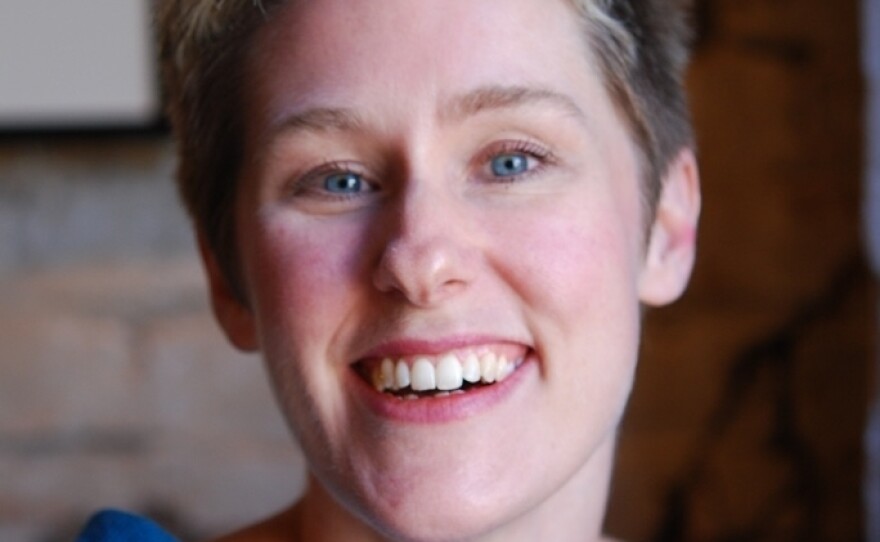There are a lot of fascinating details hiding below the surface in the world of color. For instance, scientists once thought the average color of the entire universe was turquoise — until they recalculated and realized it was beige.
In Japan, you wait at a stoplight until it turns from red to blue, even though it's the same green color as American stoplights.
And in World War II, the British painted a whole flotilla of warships pinkish-purple so they'd blend in with the sky at dusk and confuse the Germans. That's right — pink warships.
Design writer Jude Stewart's new book, Roy G. Biv, is full of facts like these. She tells NPR's Rachel Martin about the relationship between language and color, and what it's like to live with synesthesia.
Interview Highlights
On why she wanted to write about color
I'd always been fascinated by color. When I was really little, I was fascinated with this book called Color Me Beautiful and it was basically a guide to help choosing the best colors for your skin tone.
... Well I remember just paging through that book and it was just magical. They would show pictures of someone draped in their "right color" for their skin tone and they would just look dewy and glowing and suffused with light, and then they'd put them in the wrong color and they would look like they'd just shrunk.
The point is that, you know, color is affecting us a lot more than we realize. It's so ubiquitous that it's basically invisible until the moments where you notice it again.
On what "Roy G. Biv" stands for
"Roy g biv" is a mnemonic that helps you remember the order of the colors of the rainbow. So it's red, orange, yellow, green, blue, indigo and violet.
On the number of colors in the rainbow
There aren't actually, strictly speaking, seven colors in the rainbow. But when [Isaac] Newton came out with his observation about the rainbow, there was some pressure for him to make it be seven colors so that it would match the musical scale, so he had to kind of come up with indigo on the fly.
On the surprisingly universal relationship between language and color
In 1969 these two linguists, Brent Berlin and Paul Kay, did a survey of 20 different languages that were completely unrelated to each other. And they found that as languages develop differing names for colors, those names always enter the language in the same order. So that order is black, white, red, green and yellow, blue, and then brown.

So, if they're going to have only three words for colors, those words will almost always be black, white and red.
On why red is always the third color
I have my own little theory which is as I was doing the red chapter I found that red is just this primal color that, you know, unsurprisingly means blood to many cultures. And so I think probably it's just that brightness, that vitality, that sort of absolutely necessary quality to that color that makes it assert itself.
On how pink wasn't always considered a color for girls
It's an interesting question because we tend to feel that that's a really immutable rule that must have been true forever, but in fact it's a very relatively recent thing that that has become ironclad — actually in the '70s.
But, earlier, it was a question simply of what goes with the child's complexion. So the rule of thumb was often if you have brown eyes a baby looks good in pink no matter what their gender is. Blue eyes — blue.
Sometimes there were other rules. So for example, in Catholic parts of Germany it was the fashion to dress your little girl in blue, because it was an homage to the Virgin Mary. And then the boys would be in pink, because that was a watered-down version of a sort of traditionally masculine color, red.
On living with synesthesia
Synesthesia is, as I describe it, a harmless brain quirk in which you associate some stimulus with a color. So, for me, letters and numbers always have the same color. ... Seven is a sort of pale butter yellow and four is kind of a hay color, kind of a tan.
... Synesthesia is something that runs in families. So what we discovered recently — I was visiting with my parents and my brother, we were all sitting around the pool, and my brother and my mom both did not realize that they had synesthesia. We were talking about the book and my mother just blurts out, as I was describing 74 is this color, my mom says, "No, it's this color!" And then my brother had another, he's like, "No, I always thought of it as this color!" And to both of their surprises it seemed they did have synesthesia.
My father, meanwhile, has no idea what we're talking about.
Copyright 2023 NPR. To see more, visit https://www.npr.org. 9(MDAzMjM2NDYzMDEyMzc1Njk5NjAxNzY3OQ001))





